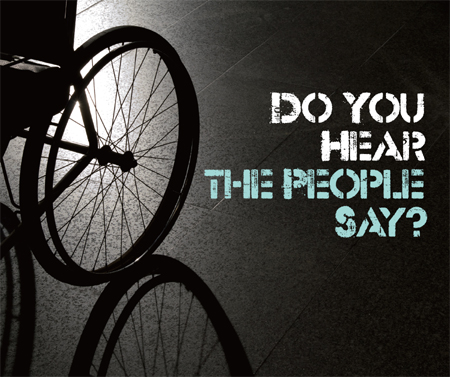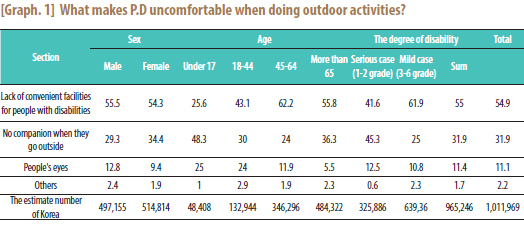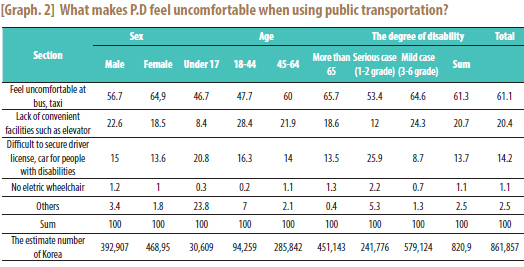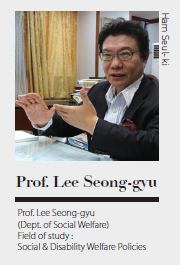Do You Hear the People Say?c

Is Our Society “Kind” for the People with Disabilities?
Does policy in Korean society work justly for P.D? Let us take a look at some of the policies being implemented in Korean society. We will analyze the current situation in two aspects: employment and welfare.
The policies we analyzed, while starting with good intentions, experienced many problems during implementation and usually caused unsatisfactory results.
Last year, 137 public institutions, over half of those in Korea, did not comply with obligations for disabled employment. According to “Promotion of Employment of People with Disabilities and Vocational Rehabilitation,” public institutions and quasi-government organizations should fill their staff with at least three percent of people with difficulties. There is a penalty for companies ignoring the rule and not hiring disabled people. To conclude, last year's allotment of money for mandatory employment was only 590,000 won per month, and this year was about 620,000 won. This means that they would prefer to face a financial penalty rather than hire P.D. Despite these mandatory rules, in reality, a big influence has not been made.
On Feb. 28, there was a protest against the failure of an election pledge. The gist of the protest concerned the “Disability Rating System,” which makes the amount of compensation received dependent on the severity of disabilities. The reason it became a problem was because, instead of considering actual degree and types of disabilities, P.D. were merely classified into bureaucratic classes. The protesters insisted on eliminating all forms of discrimination against P.D and arranging alternative measures that can practically protect the rights of P.D. Following the desires of P.D, the government’s move should be established to give more practical help to P.D, thus improving their living arrangements.
A dearth of policies, unscrupulous for P.D has inconvenienced them so far, and facilities are no exception. Many facilities in Korea do not properly do their jobs, and we need to examine some of those which lack a proper function.
The local elections, scheduled on June 4, can serve as an example of this. A big issue is the election booths newly produced for P.D. The reason they have caused problems is because they are not designed for some types of disabilities, making many P.D uncomfortable. The controversial election booth contains its election table on the right side, while a normal election booth contains its election table on the front side. The new one, in fact, was designed only for disabled people who can freely move their upper body and even use their arms and hands.
Now let us look at several necessary facilities considered to be the most basic. It is the right of everyone to move freely anywhere; however, it is not easy for P.D. According to research conducted by Ministry of Health and Welfare in 2011 (see Graph 1), the biggest inconvenience P.D face when doing their outdoor activities was “Lack of amenities for P.D,” accounting for 54.9 percent of responses. Looking at the next illustration [Graph 2], the most selected answer, when asked about difficulties with public transportation, was “Inconvenience of bus or taxi,” followed by “Lack of amenities like escalators.” As we can see in the result, significant numbers of P.D have suffered much inconvenience whenever they step out of their homes. It can even be said that their rights are being infringed.
Jongno 3ga station is large enough to have 15 exits. When you visit there, however, you will notice it has only ailing facilities which are far from enough, especially the number of escalators. The wheelchair lifts installed in the station used to be called “Lifts of death,” because of continual accidents, sometimes even leading to death. Low floor buses that have been introduced since 2003 can be seen as another example. Over are still often criticized for their low penetration rate, broken lifts, and numerous boarding accidents. According to the “Five-Year Plan for Promoting Accessibility,” there were plans to replace 50 percent of buses with low floor buses until last year, but fewer than 10 percent have been completed yet.
We looked for some examples of what policies are being enforced, how facilities function, and what problems are there for P.D in Korean society. As demonstrated from these examples, the current facilities built for P.D only seem concerned with installation itself and not function. The current policies are creating a variety of troubles and their revision seems inevitable.
Now, turn your eyes from society and look into what is happening on the stage at universities. Our university, UOS, is publicly founded and thus, should be more contributive to the society than private universities. Yet, number of prevalent problems resides in UOS as there is lack of infrastructure and facilities for students with difficulties and the duties it must perform.


UOS Policy
In 2013, six students entered UOS through a special admissions program called “students with disabilities” (hence S.D) under (fixed time). In 2014, similar to 2013, ten students were selected by this special program. Including all departments, there was an increase of four students from the previous year. However, this is still a very small number. Korea University (KU), a private university, selected 37 students aside from the jung-si quota and extended the scope of its disability grades to 6. Yonsei University selected less than one person per unit of recruitment, with 15 people within the entire unit selected. In the case of national universities, Seoul National University selected S.D. outside of a quota like KU, but only targeted disability grades 1 to 3 with a maximum of 18 students. This year, only three students were admitted. This shows that national or public universities have a more passive implementation than private ones.
Campus helper is a system in place for S.D at some universities including UOS. It is the system which provides help for S.D, including disabilities of the eyes, ears, and even feet. Since 2005, the Education Ministry, Korean Council for University College Education, and Korean National University of Welfare have promoted this system jointly. It aims to improve S.D’s learning environment and educate them to become beneficial members of society with the same opportunity as others. One might assume that this type of system is necessary; like a double-edged sword, however, criticism has risen regarding this system and UOS is no different. In reality, there are 8,012 S.D attending universities nationwide; however, Campus helpers only provide support to 30 percent of them, even though “Campus Support Program Assistant (such as Campus helper),” has been implemented for ten years. There are not only problems with limited enforcement but also within the system itself. It can be burdensome to S.D, because helpers constantly change due to a shortage in the number of assistants. The schools pay an activity fee and give service credits to helpers, yet this does not motivate them to give a hand while sacrificing their own time. Disabled Student Support Network pointed that no other infrastructure at school has this problem.

The UOS Times investigated ten buildings, which are mostly used by students. Student Hall and Six newer buildings including General Lecture and Law Institute have all three of these factors, which is helpful for S.D. In the case of the Design and Sculpture Building, however, the restroom for S.D is unclean and looks like a cabinet for cleaning tools instead of S.D facility.
The older buildings, including the Liberal Arts Building and Natural Science Building, are in a grave situation, with the former more serious than the latter. None of the facilities in the Liberal Arts Building are used by a number of humanities students at UOS. This means that so many S.D cannot get proper assistance accordingly. There is even a problem getting to the Main Library, where there is no facility girding for the stairs and a steep slope unusable for S.D. This often even makes students without impairments feel exhausted. Thus, it can be too harsh for P.D to endure these conditions.
As we can see in the result, there are still many blind spots for S.D even at our university. It surly was great work to install facilities helping P.D in recently-built buildings, but it also seems important to construct additional facilities in existing ones still lacking. They are insensitive to the needs of S.D, and a number of S.D have suffered inconveniences.
Emancipation from the Prison:
What Can be Done to Rectify the Situation?
The UOS Times asked for an advice from Professor Lee Seong-gyu (Dept. of Social Welfare of UOS) who is also the president of the Korea Employment Agency for the Disabled.
He emphasized that the term, “Barrier-free,” which expands beyond the literal meaning of physically barrier-free, is important to policy departments. P.D should be given the opportunity to build a career to break down barriers. For instance, the Learning Center for P.D at the University should be associated with the Korea Employment Agency for the Disabled so that S.D attending university can apply through this association. Also, this can lead to an intern system for the company. Regardless of the allotment for mandatory employment for P.D, companies would naturally require them. For this, university presidents need to create and encourage this business process. Consequently, creating a more capable comprehensive system of support is necessary for P.D, so everyone, including people with severe disabilities, can participate in society.
When we consider this aspect of our university, we should not forget that UOS is publicly-funded; thus, its responsibility towards this matter cannot be overlooked. When we are ready to step up and start making changes, we should be expected to serve as a role model for many other universities and cause a ripple effect. Although it is an obvious fact that everyone has a responsibility to encourage and help P.D to live without any problems, we can be the first to successfully realize a society truly fitted for all P.D.

Here is part of a public advertisement designed by Lee Jae-seok. It contains the phrase, “For some, It’s Mt. Everest,” and insists on building more handicap facilities. As it looks now, we, the “normal people,” can easily climb the stairs with little or no discomfort. For P.D, however, this might feel like climbing a mountain or worse.
It is often said that our society has already developed surroundings for P.D, but there is much work that still needs to be done. As mentioned above, it is important to implement the policy of “Barrier-free,” which integrates individual departments into a single organization with no dividing line among scheme-makings, realizing a comprehensive reinforcement of the disability field.
In fact, the disability does not always need to be treated in such a way. When we have a trouble with our eyesight, we wear glasses. These help us to see much better without giving us any inconvenience. Society itself can be compared to these glasses.
There are quite a few optical stores on the street and many frames and lenses in these stores. Although there are sufficient materials to create spectacles, if the factors required to make them are not fitted or trimmed, they can become irrelevant. Our society should proceed by not only making or arranging things but also by having them truly fitted and trimmed for P.D. To become a society in which everyone is satisfied and lives in harmony, it is time to us to keep our ears open towards those “voices” picketing with signs and keep our eyes open towards those high “barriers” around us in every corner.
Professor’s opinion

There is a long way to go. Even at our university, there are no (or not enough?) proper facilities and various conditions available for learning. Although there are some facilities, they are not complete and cannot actually help people with severe disabilities. This especially corresponds to older national and public universities which are having trouble with newly established amenities. It is also a matter of a lack of money in the municipal budget, and a structure that is not very permissive. Also, with respect to employment, we should not think of P.D as separate beings. If there is a system to check and support their intrinsic talents, all disabled people can work.
Q: What is the countermeasure of the problem?
“Barrier-free” can be a viable solution. In this sense, policies of the individual department should be connected and integrated into a single one with several ideas focusing on the disabled. It also means the convergence of each department, removing the physical barrier which prevents people with disabilities from gaining access to society. There must also be a system in place to synthetically support and encourage them so that even one more disabled person can become involved in society. This just requires more attention and endeavors, and is not impossible. “Consideration induces participation,” which means that consideration can increase social competitiveness.
Ham Seul-ki Junior Reporter
hsk9409@uos.ac.kr
Kim So-jeong Junior Reporter
bisa1994@uos.ac.kr

